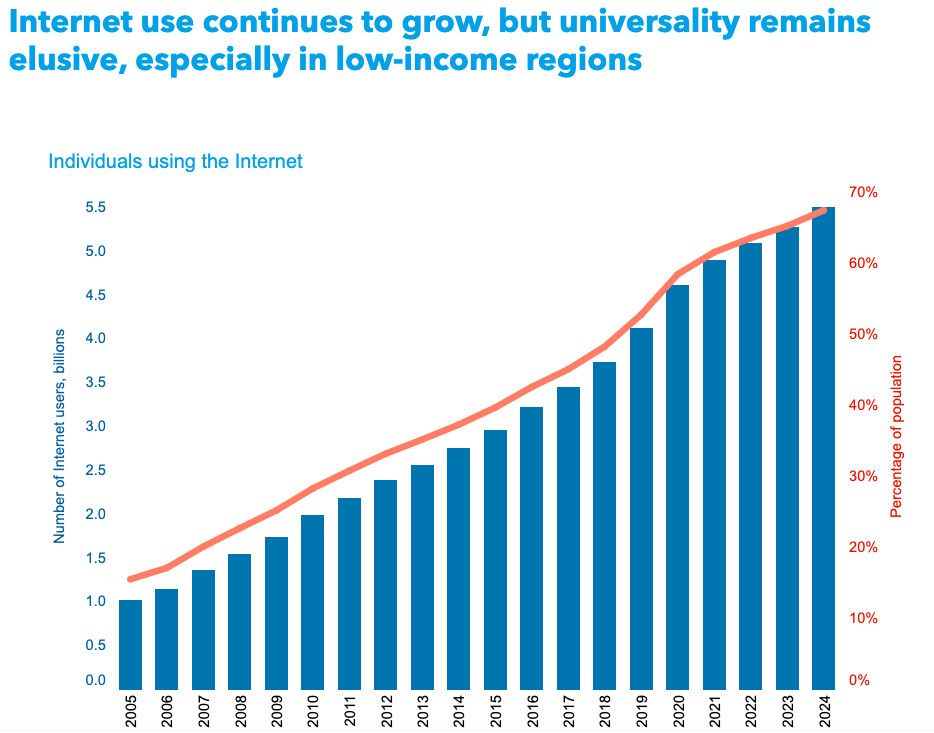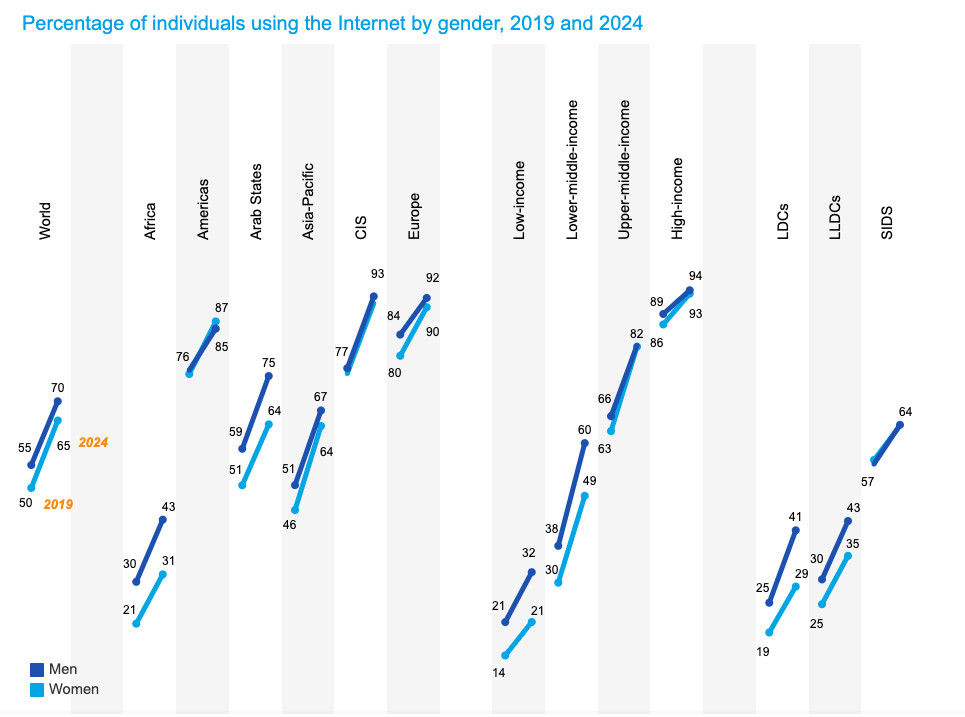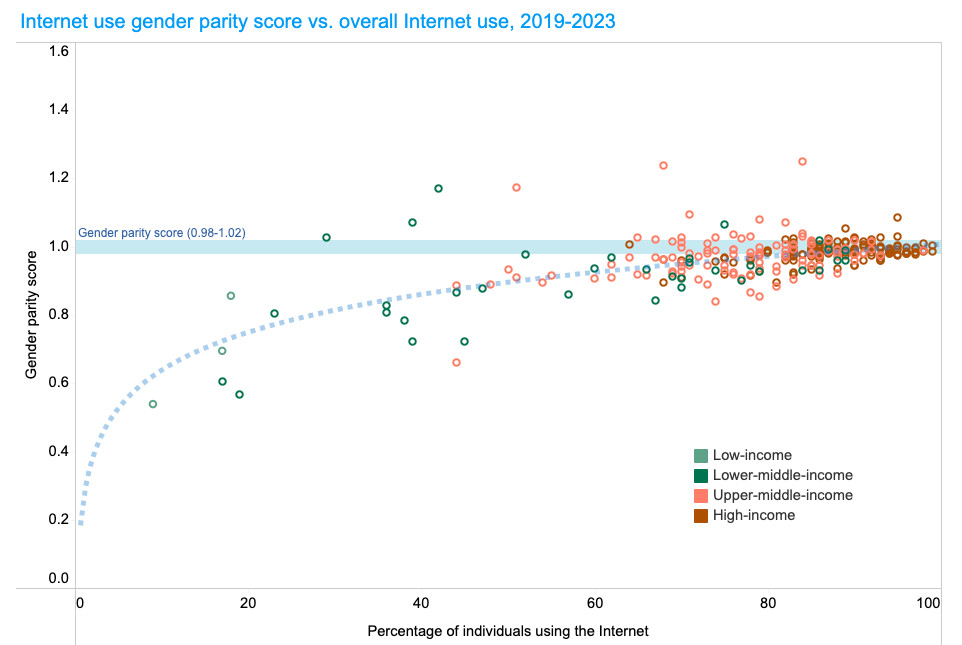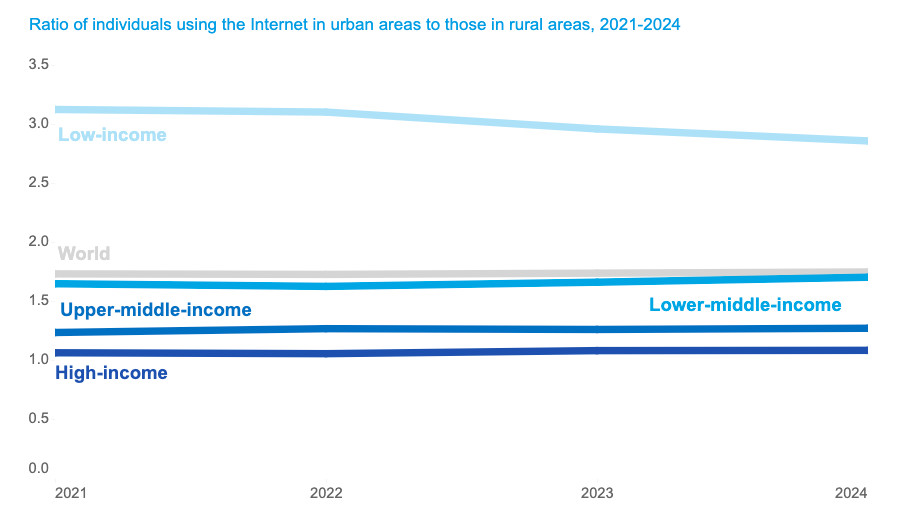Examining the Urban-Rural Internet Access Divide Reveals the Stark Global Digital Disparities
In Brief
According to the International Telecommunication Union (ITU), the number of internet users is expected to soar to 5.5 billion by 2024, marking a rise of 227 million compared to the figures from 2023. Unfortunately, the barriers are particularly pronounced for those in low-income regions, leaving around 2.6 billion individuals still offline.

A nation's growth trajectory is closely tied to how many of its citizens are utilizing the internet. By 2024, it's estimated that 93% of individuals in affluent countries will be online, whereas a mere 35% of those in the world's least developed countries (LDCs) and just 27% in low-income nations can say the same. Landlocked developing countries don't fare much better, with 39% connectivity—still falling short of the global average.
This divide is exacerbated by socioeconomic and geographical barriers. Rural regions particularly suffer from inadequate infrastructure development. As a result, only 48% of people living in rural areas can access the internet, while a significant 83% of urban residents across the globe are connected. Of the 2.6 billion individuals offline, a staggering 1.8 billion live in these rural spaces, emphasizing the immediate need for tailored solutions for underserved communities.

Photo: ITU
The Global Connectivity Landscape Shows Gender Disparities

Photo: ITU
Internet Use Disparities by Gender
In 2024, it’s anticipated that there will be 189 million more male internet users than female users, with 70% of men online versus 65% of women. While there's been progress toward closing this gender gap, particularly in wealthier nations, it remains pronounced in low-income regions, reflecting deeper societal issues related to gender roles, education, and employment.

Photo: ITU
A notable 79% of those aged 15 to 24 will be online in 2024, highlighting that younger generations are more inclined to engage with the internet. This higher adoption rate underscores their identity as digital natives. However, the disparity between the youth and older segments of the population is diminishing. Initiatives aimed at promoting digital literacy across all age demographics are becoming increasingly vital.
For developing nations, the expense of internet access remains a significant hurdle. Although costs for fixed broadband subscriptions have notably decreased, for individuals in low-income areas, these services can consume about a third of their average monthly income. Meanwhile, while mobile broadband might be more accessible, it typically offers limited data plans and slower speeds compared to fixed options.

Photo: ITU
Challenges of 5G Advancement and Urban-Rural Disparities
Mobile technologies play a crucial role in bridging the digital divide. Globally, over 80% of individuals aged ten and above possess a mobile phone. However, this statistic masks the disparity in ownership; in wealthy nations, the figure exceeds 95%, but it plummets to 56% in poorer countries.
Despite the emerging opportunities that 5G technology brings, it underscores persistent inequalities. By 2024, while it's projected that 51% of the global populace will be within reach of 5G networks, affluent areas will enjoy 84% coverage, in stark contrast to a mere 4% in low-income regions.

Photo: ITU
Significant investments in digital infrastructure predominantly benefit urban areas, leaving rural locations lagging far behind. This urban-rural rift exacerbates broader economic and social inequalities. Connectivity is not just about convenience; it’s essential for enhancing healthcare access, improving educational outcomes, and increasing agricultural productivity in rural areas, thereby empowering communities.
The Wider Implications of Digital Exclusion
Digital exclusion compounds pre-existing disparities by limiting access to essential services, educational resources, and job opportunities. Many vital platforms, including e-commerce, healthcare, and online learning resources, remain unreachable for those without internet access. The marginalized communities bear the brunt of these restrictions, which perpetuate cycles of poverty.
Tackling the digital divide requires a comprehensive approach. Collaborative efforts among governments, businesses, and international organizations are crucial to addressing issues of affordability, digital literacy, and infrastructural gaps. For meaningful progress, investment must be prioritized in neglected regions, especially those facing challenges of poverty and rural isolation.
Policymakers should aim to reduce internet access costs through innovative funding approaches, public-private partnerships, and subsidies. Enhancing digital skills and literacy initiatives, with a special focus on empowering women and marginalized groups, will further promote equitable access. Creating affordable devices and expanding mobile broadband coverage are also key actions.
Universal internet connectivity is not merely a technological goal; it’s a fundamental socio-economic imperative. Access to the internet empowers individuals by providing them with information, enabling participation in the global economy, and facilitating advocacy for their rights. Greater connectivity fosters social cohesion, innovation, and economic growth.
Despite recent advancements, the current pace of digital inclusion falls short of international objectives. The ITU's call for intensified efforts underscores the urgency of bridging the digital divide. By dismantling barriers to connectivity and advocating for inclusive policies, the global community can ensure that everyone benefits from the internet’s vast opportunities.
As the global internet user base continues to swell, disparities in access reveal the uneven distribution of technological progress. The existing digital chasm between high-income and low-income regions, urban and rural areas, and various demographic groups underscores the challenge of achieving universal connectivity.
To bridge this gap, investments must target underserved regions, address structural inequalities, and foster universal access to digital technology. A connected world is essential for justice, opportunity, and advancement; it transcends mere technological considerations. A truly inclusive digital future can only be realized when no one is left behind.
Disclaimer
In line with the Trust Project guidelines , please acknowledge that the content presented on this page is not intended as legal, tax, investment, financial, or any other type of professional advice. It is crucial to only invest what you can afford to lose and to seek independent financial counsel if unsure. For additional guidance, we recommend consulting the terms and conditions as well as the support resources provided by the issuer or advertiser. MetaversePost is dedicated to delivering accurate, impartial reporting, but market conditions can fluctuate rapidly without notice.







